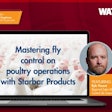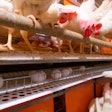
By placing baits and traps in the correct location and rotating active ingredients, poultry growers and egg farmers can successfully limit disruptions caused by nuisance insects.
In a WATT Poultry Chat interview, Starbar Regional Sales Manager Mike Nash explained the importance of pest control and shared his advice on using traps and baits in poultry environments.
Austin Alonzo: Why should producers care about insect control on poultry operations?
Mike Nash: That's a good question to start with. And the good news is, actually the best news is that the producers do care about insect control, and they have a plan in place for insect control.
Once we understand the extent of an insect infestation, we begin to put a plan together. Right now, what we put together is called an integrated pest management plan.
Producers are well aware of the fact that insects can cause disease and reduced production and may decimate an entire flock in fact, especially when Salmonella is a concern and E. Coli is a concern. Really, layers care more about flies, that's the primary pest that they focus on. Broilers care more about beetles. Now, with the advent of cage-free, and colony enriched housing, we have a situation where beetles are beginning to show up in some of those places. So, that may change over time.
So as we begin putting together the Integrated Pest Management (IPM) program, really what we do initially is what we call "PIE." We plan, we implement and then we evaluate to see how well that integrated pest management program is working. Right now, we're talking about birds. Right? There's people in those production operations, and they're not real fond of working in an environment that pest ridden, by flies or beetles or -- we're not talking about bedbugs today, but there's where they're prevalent, that can be a very real challenge that a lot of these operations. We have enough acronyms in the world. We work with acronyms like IPM, people are very well acquainted with integrated pest management and very, very well acquainted with PIE where we plan, implement and evaluate.
Austin Alonzo: How can traps be used to monitor and control nuisance insects on poultry operations?
Mike Nash: Traps can be used to monitor and they can be a very important part of your integrated pest management program. As we look at IPM, we look at the right level of product placement, it's very important to put products in the right place, we know that flies feed down low. So we put baits and fly bait sprays and our abatement strip down low. We put the bottles or the pheromone traps the bottles or jugs at about head level. And then we put our sticky traps up high where flies rest. So, they can be used to monitor but they also can be used to capture flies as part of that integrated pest management program.
Austin Alonzo: How can using baits in a rotation help protect poultry operations?
Mike Nash: Baits are used in a rotation so we avoid resistance. Right? We are in the pest management manufacturing business. So, we have four different baits. We have Golden Marlin, that's been around, Quickstrike, Cyanarox, and now we're introducing a bait called Durastrike with four different active ingredients, four different modes of action. And, its very important to rotate those baits. The real estate business says, "Location, location, location," we say, "Rotation, rotation, rotation." Rotate the baits to avoid resistance and continue having an effective, successful IPM program.
Austin Alonzo: Where can people learn more about Starbar?
Mike Nash: Starbarproducts.com, a great website that we have. It has labels, SDS, it has some videos, and a lot of good information about insect control not just flies, but also beetles, mosquitoes, fire ants, those types of things. So I recommend going to starbarproducts.com. Have a look there. And if you have questions, there's an 800 number out there. I can read that to you. That's 800-357-8272, you call the 800 number for customer service. They'll get you they'll get in touch with us and we'll get in touch with you and help you any way we can.
This transcript edited for length and clarity.
















